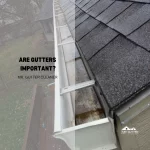Gutter maintenance is pivotal in preserving a home’s integrity and functionality. Ignoring gutter cleaning can lead to severe consequences, such as water damage, foundation issues, and unwelcome pest infestations.
Clean gutters, on the other hand, divert rainwater away from your home, safeguarding the roof, walls, foundation, and landscape from damage.
Signs like visible plant growth, water spillage during rain, and sagging gutters are clear indicators that your gutters need attention.
Moreover, stained siding or paint peeling, the presence of pests, rust and holes in the gutters, and water damage or mildew around the foundation are symptoms of neglected gutter maintenance.
Recognizing these signs early can prevent costly repairs and maintain your home’s value. This overview emphasizes the importance of regular gutter maintenance, from DIY cleaning tips to knowing when to call professionals.
It also highlights the impact of seasonal changes on gutter health and the cost-benefit analysis of regular upkeep, providing homeowners with essential insights into proactive gutter maintenance.
Why Is Gutter Maintenance Crucial for Your Home?
Gutter maintenance forms a critical component of home upkeep, directly influencing the building’s longevity and inhabitant safety. Neglecting this duty can lead to a series of detrimental outcomes, while adherence ensures the home’s structural integrity and aesthetic appeal.
What Happens When You Neglect Gutter Cleaning?
Neglecting gutter cleaning culminates in numerous issues, including water damage, foundation problems, and increased likelihood of pest infestations. Blocked gutters fail to divert water away properly, causing overflow that can damage both the interior and exterior of a home. This stagnation of water also creates a fertile breeding ground for pests and can lead to the deterioration of the building’s foundation, posing severe risks to its structural integrity.
Table of Contents:
- Why Is Gutter Maintenance Crucial for Your Home?
- Sign 1: Visible Plant Growth
- Sign 2: Water Spillage During Rain
- Sign 3: Sagging Gutters
- Sign 4: Stained Siding or Paint Peeling
- Sign 5: Pest Infestations
- Sign 6: The Presence of Gutter Rust and Holes
- Sign 7: Water Damage or Mildew Around the Foundation
- Preventative Measures for Gutter Maintenance
- DIY Gutter Cleaning Tips
- The Impact of Seasonal Changes on Your Gutters
- FAQs About Gutter Cleaning
How Can Clean Gutters Protect Your Home?
Clean gutters safeguard a home by ensuring efficient water diversion away from the building’s foundation, walls, and landscaping. This prevention of water buildup mitigates the risks of water damage, basement flooding, and the erosion of landscaping. Moreover, it reduces the chance of rust and corrosion on guttering systems, extending their lifespan and maintaining the home’s exterior appearance. Regular gutter maintenance also deters pests by eliminating the stagnant water and debris that serve as their habitats, contributing to a healthier and safer home environment.
Sign 1: Visible Plant Growth
The presence of plants in your gutters is not just a minor inconvenience; it’s a red flag signaling neglect and potential damage. This vegetation, ranging from small weeds to large bushes, indicates that debris has accumulated sufficiently to support plant life, highlighting a critical blockage that impedes water flow.
What Does It Mean If Plants Are Growing in Your Gutters?
Plants growing in gutters mean that seeds and soil have found a hospitable environment in the debris that has accumulated over time. This situation not only adds weight and strain to the gutter system, potentially leading to damage, but it also obstructs water flow, increasing the risk of water damage to the home’s structure and foundation.
Sign 2: Water Spillage During Rain
Water spillage from gutters during rainfall is a clear indicator of obstruction. Instead of being channeled away from the house, water overflows the gutter’s edge, leading to potential damage where it’s least expected.
How Does Water Overflow Indicate Gutter Blockage?
Overflowing gutters during rain suggest a blockage that prevents water from flowing through the gutter system as designed. This blockage can result from accumulated debris, such as leaves and twigs, which causes water to spill over the sides of the gutters, potentially damaging the home’s siding, foundation, and landscaping.
Sign 3: Sagging Gutters
Sagging gutters are a sign that your gutter system is under excessive stress, often due to the weight of debris, water, or ice. This sagging can lead to a complete system failure if not addressed promptly.
Why Do Gutters Begin to Sag?
Gutters sag because the weight they are carrying exceeds their design limits. This excess weight can come from debris accumulation, standing water due to clogs, or ice formation in colder climates. Over time, this weight strains the gutter brackets and hangers, leading to sagging, detachment from the home, and ineffective water drainage.
Sign 4: Stained Siding or Paint Peeling
Stained siding or peeling paint around gutters is not merely an aesthetic issue; it signifies that water is misdirected onto the home’s exterior surfaces rather than being properly channeled away.
Can Gutter Issues Cause Exterior Home Damage?
Yes, gutter problems can lead to significant exterior home damage. When gutters are clogged or improperly aligned, water can spill over and run down the side of the house, leading to stained siding or peeling paint.
Over time, this persistent moisture can cause wood rot, mold growth, and even structural damage to the home’s exterior.
Sign 5: Pest Infestations
Pest infestations in gutters are a common consequence of neglecting gutter maintenance. Clogged gutters can create a hospitable environment for various pests, turning what should be a simple water diversion system into a breeding ground for unwanted visitors.
What Kinds of Pests Are Attracted to Clogged Gutters?
Clogged gutters can attract a variety of pests, including mosquitoes, birds, rodents, and insects.
The stagnant water in clogged gutters offers an ideal breeding ground for mosquitoes, while debris provides nesting materials for birds and rodents. Insects such as ants and termites are also drawn to the moisture and debris, potentially leading to more severe infestations within the home itself.
Sign 6: The Presence of Gutter Rust and Holes
Rust and holes in gutters compromise their integrity and functionality. These issues typically result from prolonged exposure to water and debris, which can corrode metal gutters over time.
How Do Rust and Holes Affect Gutter Functionality?
Rust and holes can significantly impair gutter functionality by allowing water to leak rather than be properly channeled away from the home. This leakage can lead to water damage on the home’s exterior surfaces and around the foundation. Additionally, the structural integrity of the gutters can be compromised, leading to sagging or complete failure of the gutter system.
Sign 7: Water Damage or Mildew Around the Foundation
Water damage or the appearance of mildew around a home’s foundation are serious indicators that the gutter system is not functioning correctly. These signs suggest that water is not being diverted away from the house effectively.
Why Is Foundation Water Damage a Serious Concern?
Foundation water damage is a critical concern because it threatens the structural integrity of the entire home. Water pooling around the foundation can lead to erosion, weakening the foundation over time. Additionally, water infiltration can cause basement flooding, mold growth, and mildew, which can compromise indoor air quality and require costly repairs. Protecting the foundation from water damage is essential for maintaining the home’s safety, value, and livability.
Preventative Measures for Gutter Maintenance
Maintaining your gutters is crucial to ensure they function properly, protecting your home from water damage. Implementing preventative measures can significantly reduce the risk of gutter-related issues.
Regular Cleaning Schedules
Establishing a regular cleaning schedule for your gutters is one of the most effective ways to prevent clogs and ensure smooth water flow. Gutters should be cleaned at least twice a year, typically in the spring and fall, to remove leaves, twigs, and other debris that can accumulate and cause blockages. More frequent cleaning may be necessary if your home is surrounded by trees that shed heavily.
Installing Gutter Guards
Gutter guards can be a valuable addition to help minimize the amount of debris entering your gutters. These devices cover the gutter, allowing water to enter while keeping leaves and larger debris out. There are various types of gutter guards available, including mesh screens, foam inserts, and surface tension units, each with its advantages and considerations for installation.
DIY Gutter Cleaning Tips
Cleaning your gutters is a task that many homeowners can undertake themselves with the right preparation and safety measures in place. Here are tips to ensure effective and safe gutter cleaning.
Safety First: What You Need to Start
Safety should be your top priority when cleaning gutters. Ensure you have a sturdy ladder that can reach your gutters comfortably. Wear gloves to protect your hands from sharp objects and debris, safety goggles to protect your eyes, and non-slip shoes to prevent falls. It’s also advisable to have someone with you to stabilize the ladder and provide assistance if needed.
Step-by-Step Guide to Cleaning Your Gutters
- Prepare Your Tools: Gather a ladder, gloves, a bucket for debris, a garden trowel or gutter scoop, and a hose with a spray nozzle.
- Remove Debris: Starting at the downspout, use the trowel or scoop to remove debris, placing it in the bucket. Work your way along the gutter, being careful not to lean too far over or put too much weight on the gutter.
- Flush the Gutters: Once the debris is removed, use the hose to flush the gutters, starting at the end opposite the downspout. This will help remove any remaining small debris and check for proper water flow.
4. Check Downspouts: Ensure that water flows freely through the downspouts. If there is a blockage, it may be necessary to use a plumber’s snake to clear the path.
5. Inspect for Damage: While cleaning, inspect your gutters for any signs of damage, such as rust, holes, or sagging sections, and plan for necessary repairs.
The Impact of Seasonal Changes on Your Gutters
Seasonal changes can significantly affect your gutters, necessitating specific maintenance practices to ensure they remain functional throughout the year.
Preparing Your Gutters for Winter
Before winter sets in, ensure your gutters are clear of all debris to prevent ice dam formation, which can lead to significant damage. Additionally, check that all gutters and downspouts are securely attached to handle the added weight of snow and ice.
Summer Maintenance Tips
Summer storms can bring down leaves and debris, clogging gutters quickly. Regular inspections and cleaning after heavy storms can prevent blockages. It’s also a good time to check for any damage caused by spring rains and address them before the harsher winter weather.
FAQs About Gutter Cleaning
Understanding the cost and value implications is essential when investing in quality gutter systems for modern homes. This aspect of home maintenance is not just about the immediate expenses but also about the long-term benefits and savings that quality gutters provide.
Can I Clean Gutters Myself?
Yes, many homeowners can perform gutter cleaning themselves, especially if they are comfortable working on a ladder and their home is not exceptionally tall. Essential tools for the job include a sturdy ladder, gloves, a garden trowel or gutter scoop, and a hose. However, safety should always be the priority, and it’s important to know your limits to avoid accidents.
How Do I Know My Gutters Need Cleaning?
Signs that your gutters need cleaning include visible plant growth, water overflowing during rain, sagging gutters, and the presence of pests. Additionally, if it has been a significant amount of time since the last cleaning, it’s wise to inspect and likely clean them, even if these signs are not yet apparent.
What Are the Risks of DIY Gutter Cleaning?
While DIY gutter cleaning can be cost-effective, it comes with risks, particularly falls from ladders, which can lead to serious injury. There’s also the risk of damaging the gutters if not handled carefully. Wearing appropriate safety gear and using the right tools are crucial to minimizing these risks. If you’re unsure or uncomfortable, it’s best to hire professionals.


